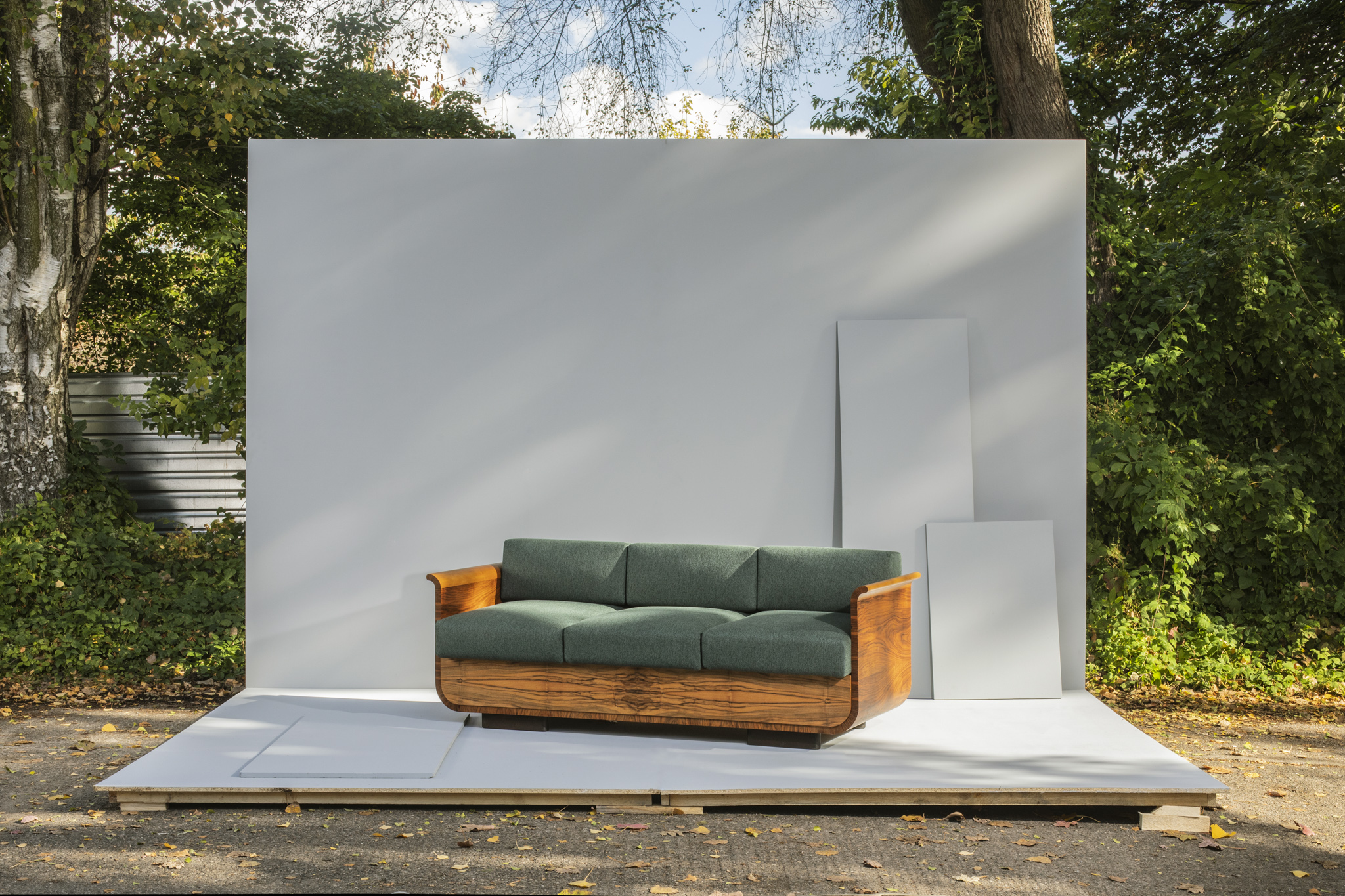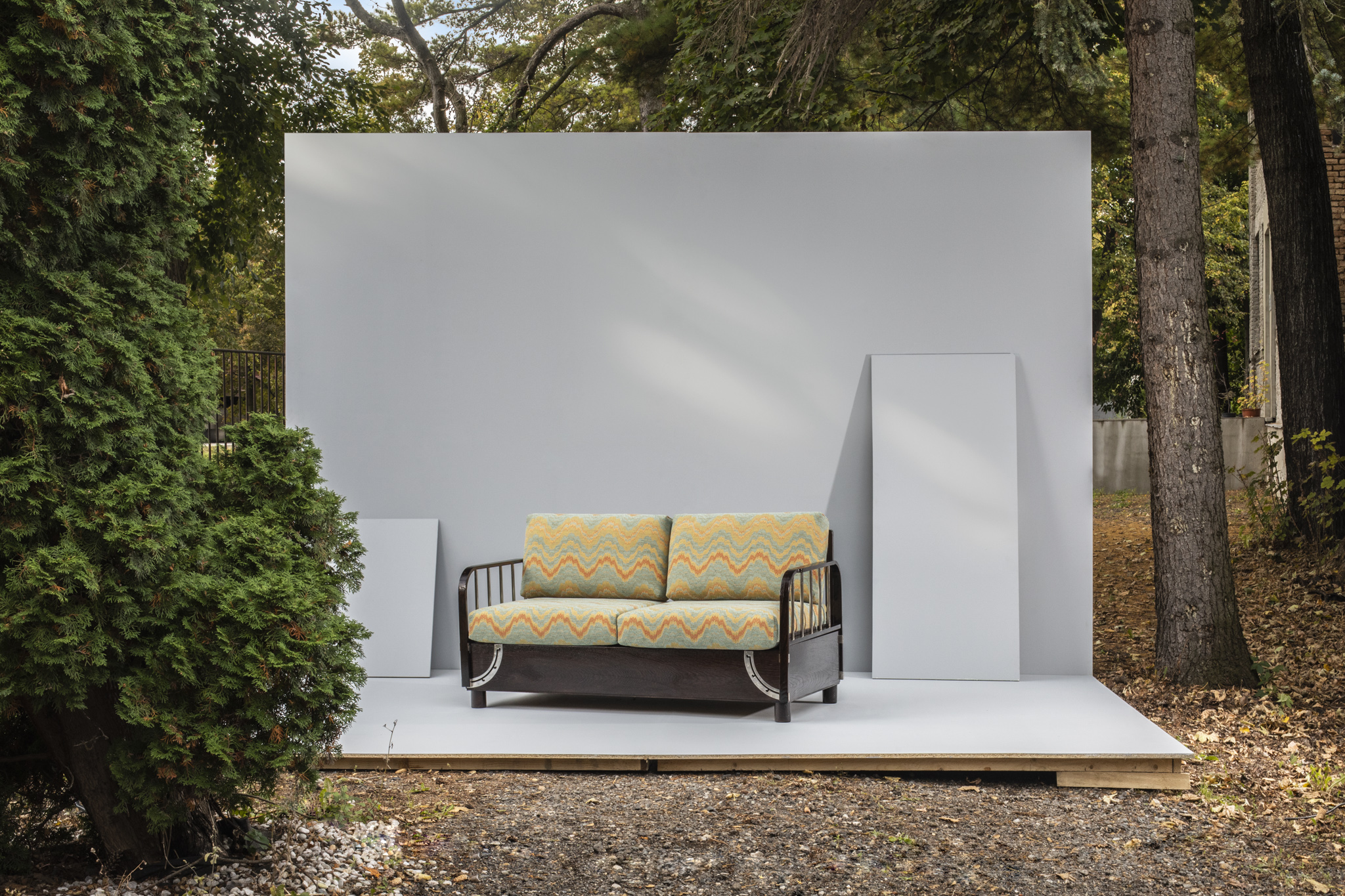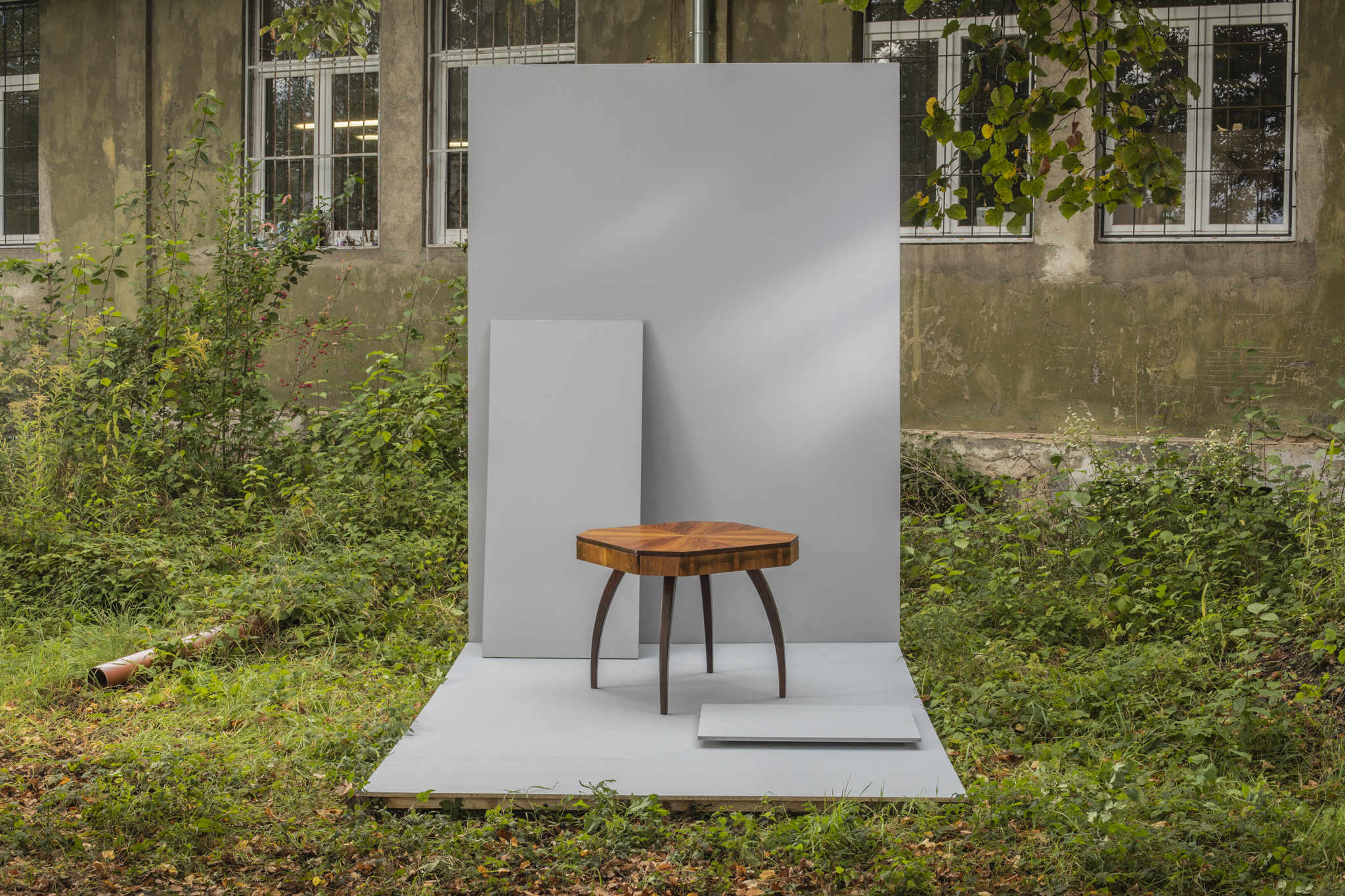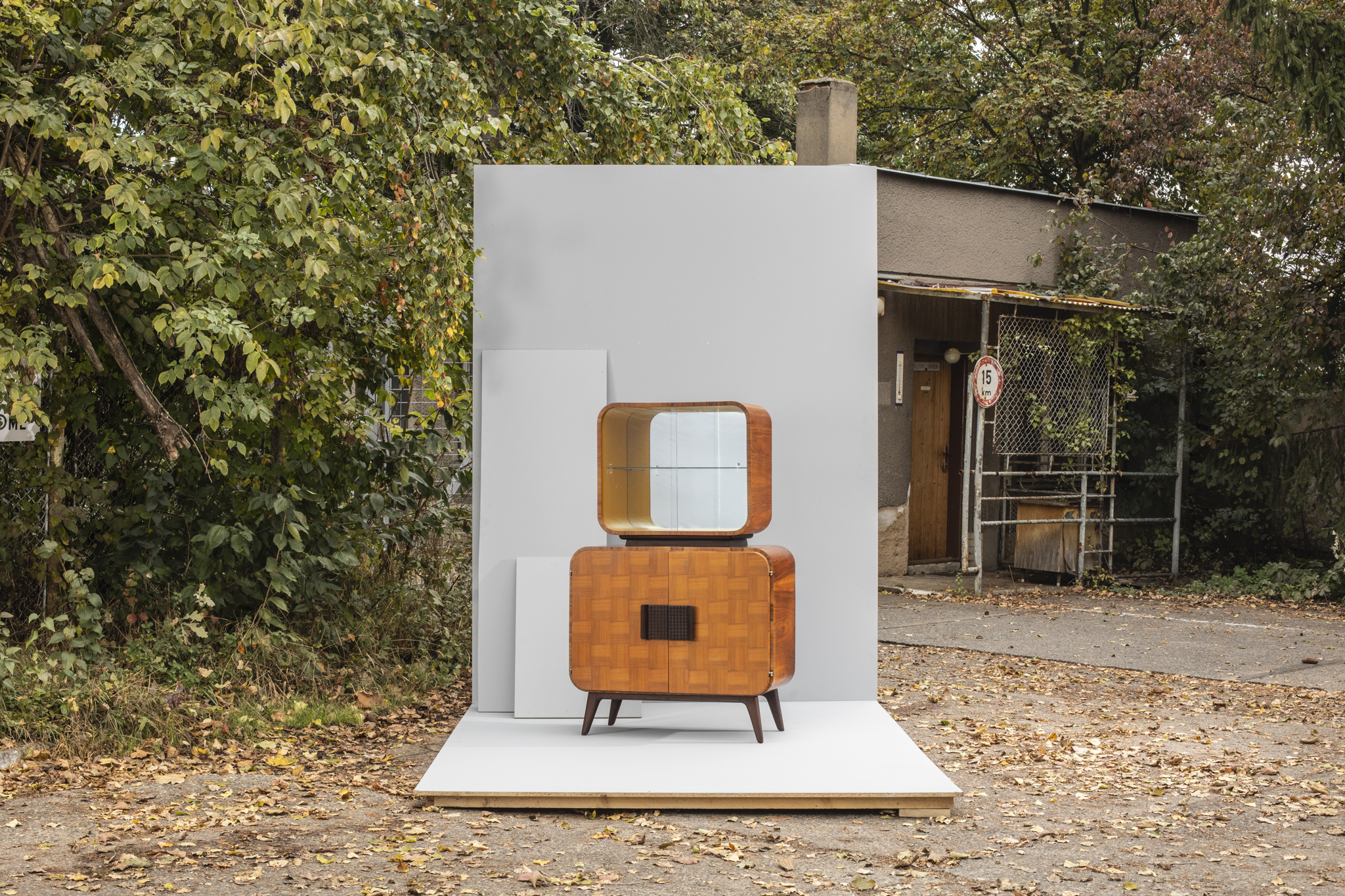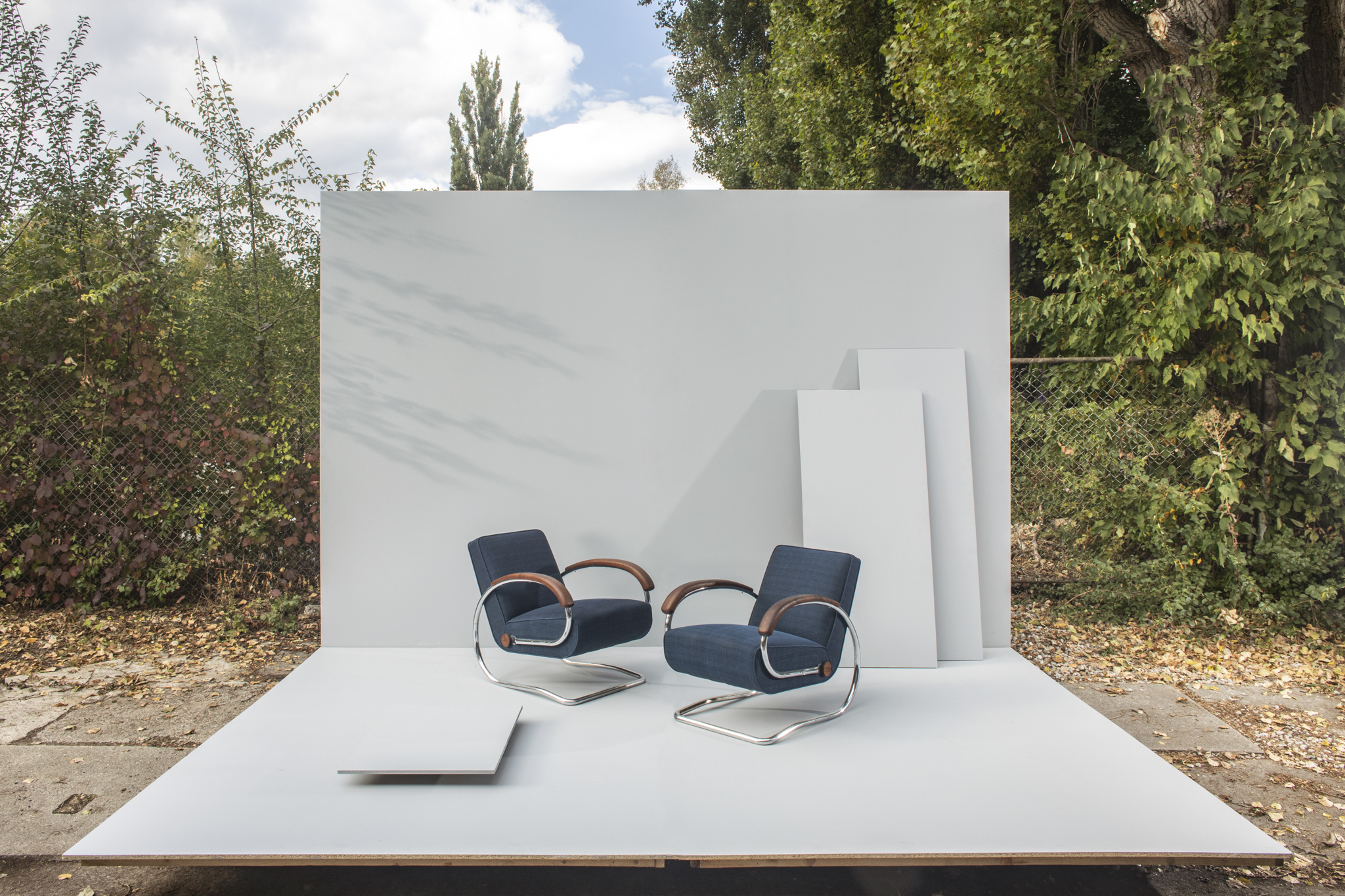We recently managed to put together this exclusive collection of five original items created by Jindřich Halabala, one of the most renowned Czech furniture designers of the twentieth century.
This set showcases some of the distinctive designs Halabala made for the company Uměleckoprůmyslové Závody in the period between 1930 and 1960. Together they display his skill, ingenuity, and range as a designer.
Halabala’s sleek, functionalist furniture has been representing Czechoslovak design in auction halls around the world for years, and due to its international popularity, it’s getting harder and harder to come by. That’s why we were thrilled to get our hands on these five unique items.
Each piece in this set has undergone a complete renovation in our workshop. We used a similar renovation process for all of them and tried to preserve the original feel of the furniture. All of the wooden parts have been restored using natural oils and waxes, and the cushions have been reupholstered.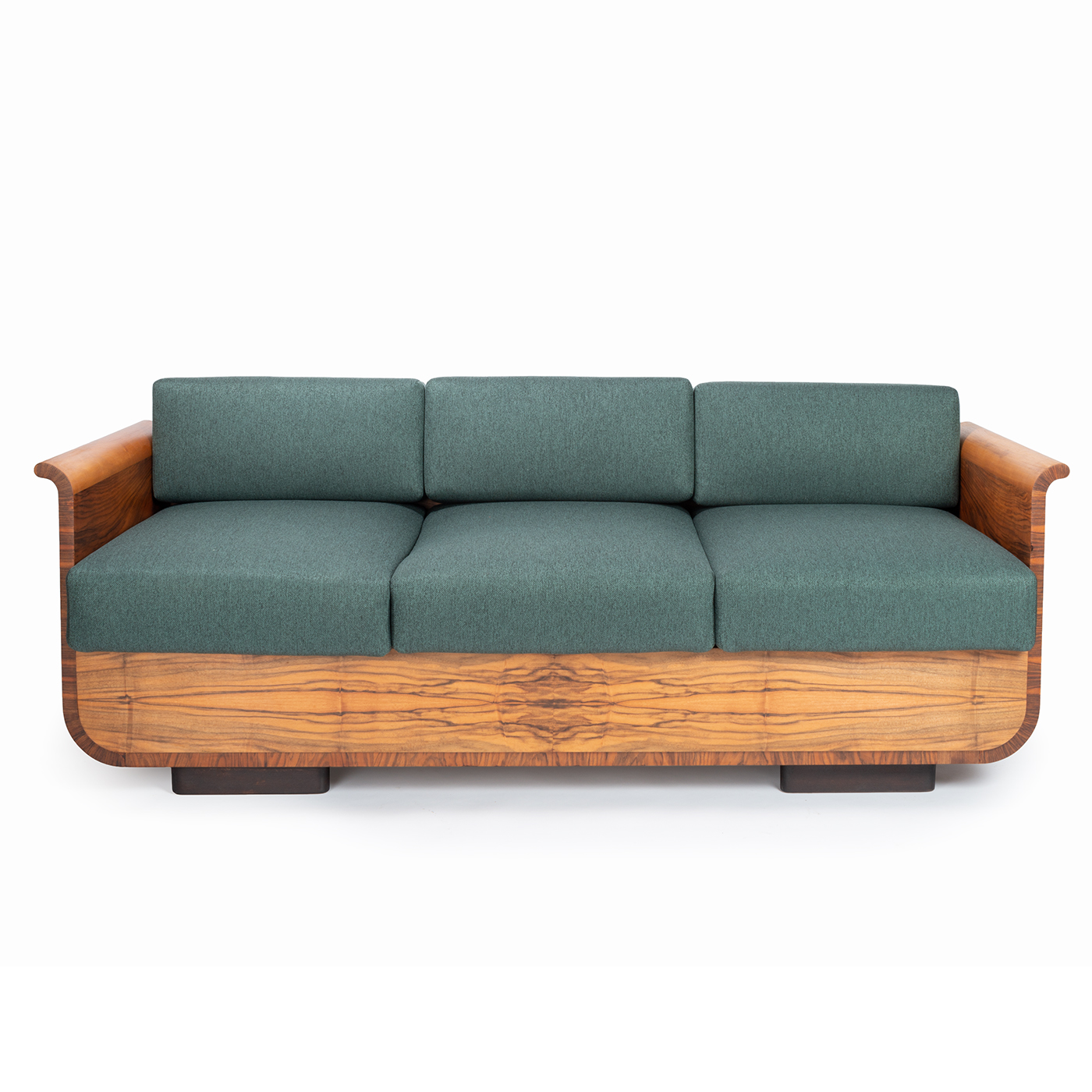
Sofa H-162
Wooden “Tulip” sofa model H-162, designed by Jindřich Halabala in the 1940s for the company Uměleckoprůmyslové Závody. Halabala was originally a cabinetmaker by trade but later studied at the Academy of Arts, Architecture & Design in Prague under Professor Pavel Janák, and this influence is likely where his designs got their clean, functionalist form.
The frame of the sofa is made from spruce with a walnut veneer, and its features call to mind the Czechoslovak pre-war style of Art Deco. The bottom edge of the frame curves gracefully upward and outward in one continuous line to form the armrests, an element Halabala applied to a number of his designs, nicknaming it the “tulip”. The cushions sit atop a hinged lid, which can be lifted to access a large storage space underneath. The entire sofa has been completely refurbished in our workshop, including the creation of new cushions, which are upholstered in a green fabric.
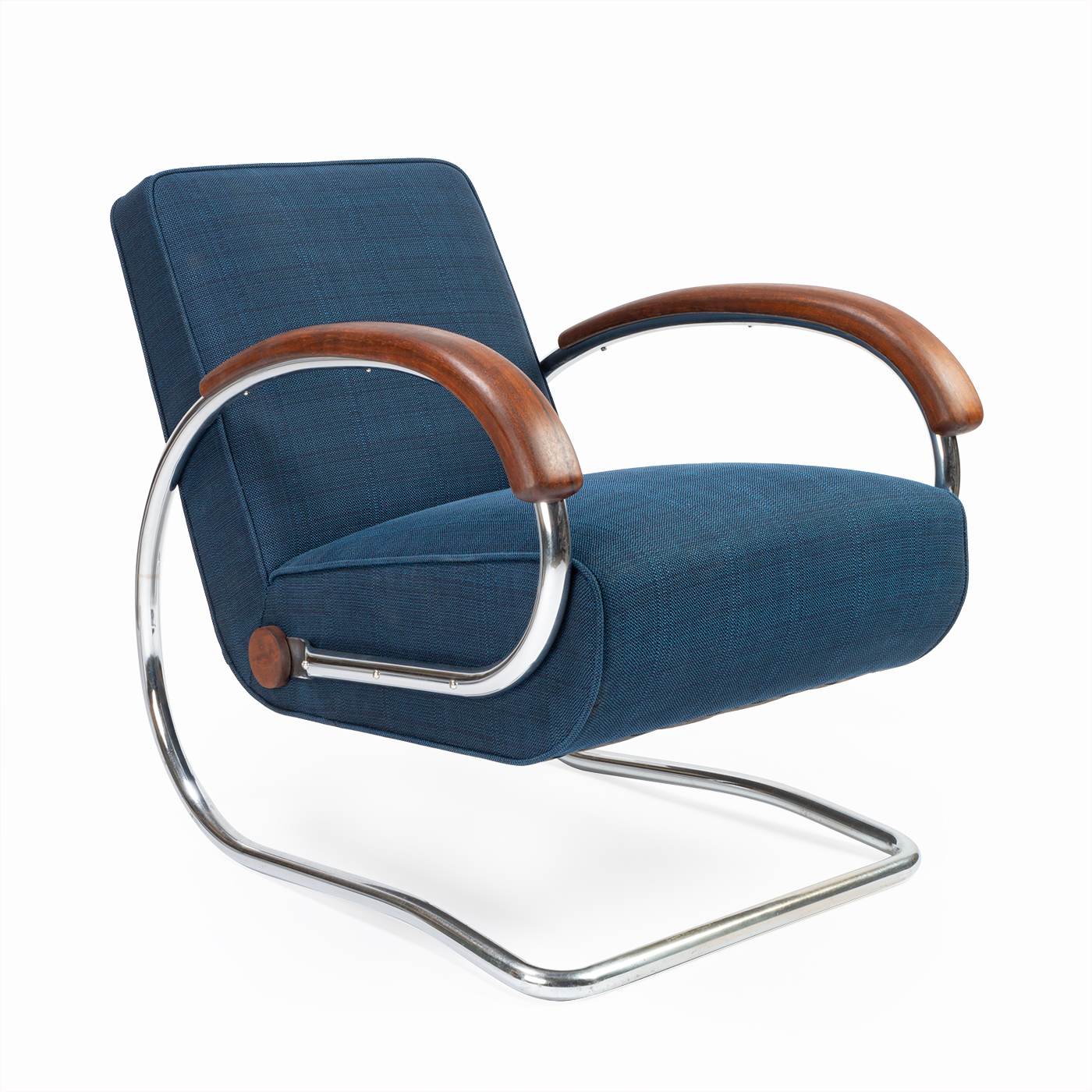
Armchair H-221
Armchair model H-221, designed by Jindřich Halabala in the 1930s for the company Uměleckoprůmyslové Závody. The birth of modern tubular steel furniture design dates back to 1925, when Marcel Breuer constructed his first prototype armchair using the material. After 1930, interest in tubular steel furniture grew steadily, and it began to be used not only in functionalist interiors but also in mass-produced pieces aimed at the broader public.
The ingenuity of Halabala’s designs lay in his utilization of the spring-like properties of steel tubing to create constructions based on a single, curved line. His decision to design a chair without front legs was due to the issue of suspension. He said, “In the earlier models, the flexibility was one-sided. With these chairs, the design is chosen so that the chairs have the same range of backward and forward flexibility. This avoids the falling sensation that one felt with backward springing chairs.” Halabala saw steel furniture as a light and transparent alternative to earlier wooden designs. Halabala's most important models date from 1931, so his work was at the forefront of the development of the industry and became some of the most well-known and exclusive furniture of its kind.
These two particular armchairs underwent a complete refurbishment in our workshop. The wooden parts have been refinished with a matte coating of natural oils and waxes. Our restoration of the cushions involved replacing all of the horsehair and natural plant fibre stuffing while preserving the original spring system.
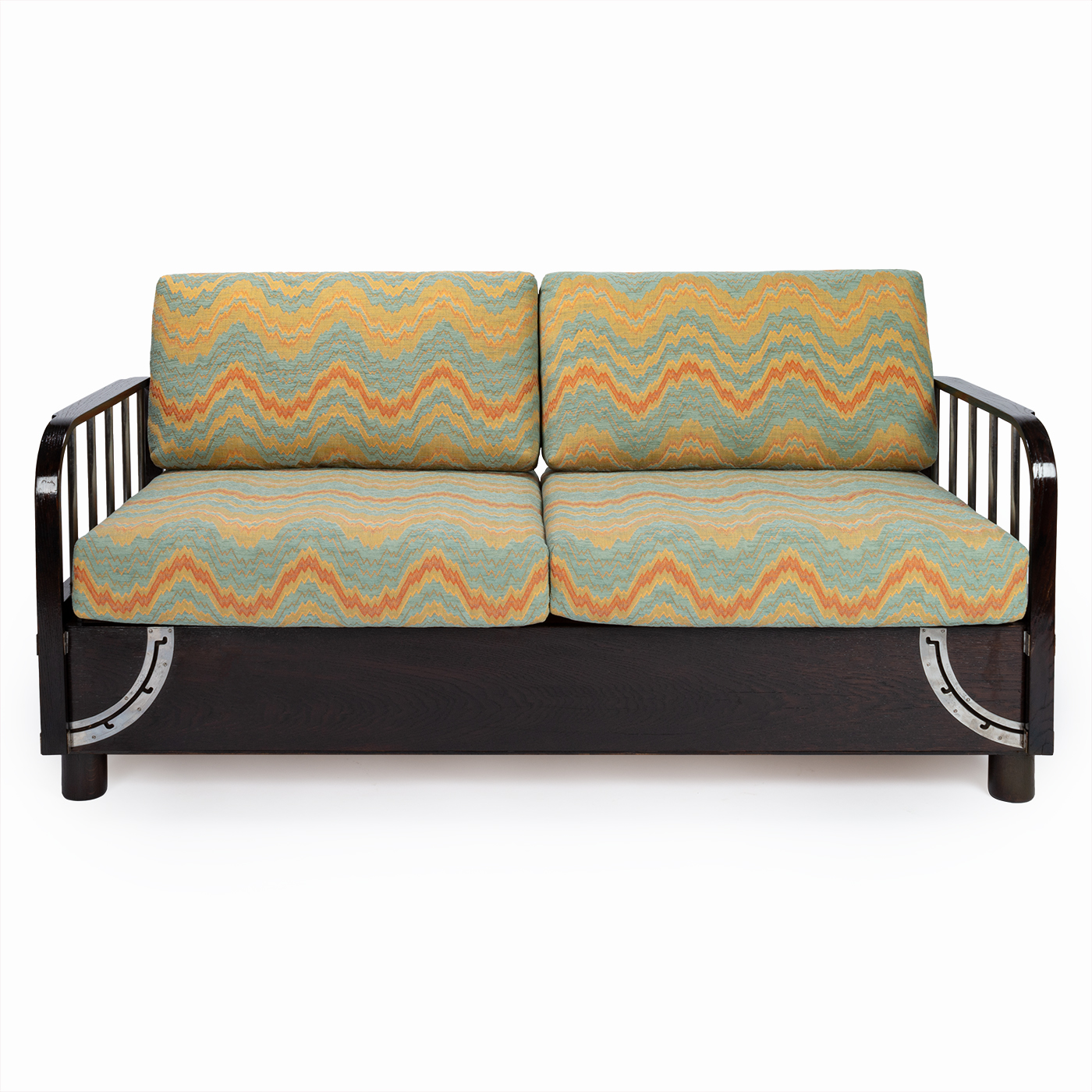
Modela sofa
Functionalist wooden sofa named the Modela, designed by Jindřich Halabala in the 1930s for the company Uměleckoprůmyslové Závody. Halabala created this design early in his career as the lead architect of UP Závody, and it was one of the most popular sofas that the company ever produced. Halabala was originally a cabinetmaker by trade but later studied at the Academy of Arts, Architecture & Design in Prague under Professor Pavel Janák, and this influence is likely where his designs got their clean, functionalist forms.
The frame of this sofa is made from solid beech, and the armrests which can fold down into four different positions, allowing the sofa to be converted into a bed. The piece has been completely refurbished, including the folding system and new upholstery with a colourful fabric.
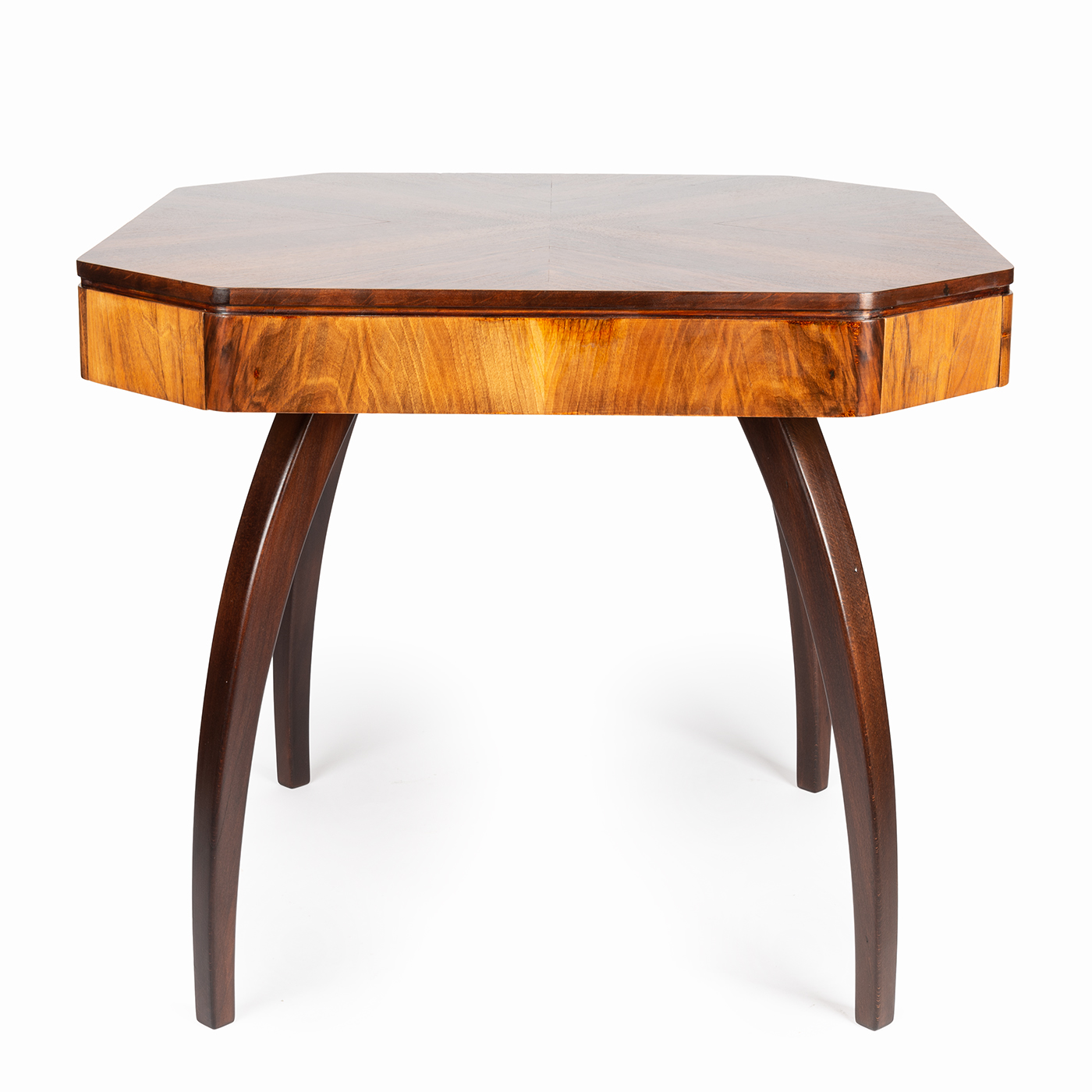
Card table H-278
Card table model H-278, designed by Jindřich Halabala in the early 1950s for the company Uměleckoprůmyslové Závody. The table was produced in a limited run, making it a very rare piece today. Originally a cabinetmaker by trade, Halabala later studied at the Academy of Arts, Architecture & Design in Prague under Professor Pavel Janák, and this influence is likely where his designs got their clean, functionalist forms.
The top of this table is made from solid spruce with a walnut veneer. It has the same solid beech legs as the more well-known “Spider” model, but each of the four corners has a narrow drawer with a wave-shaped tin insert for storing cards. The table underwent a complete renovation in our workshop using natural oils and waxes, and the drawers have been thoroughly cleaned.
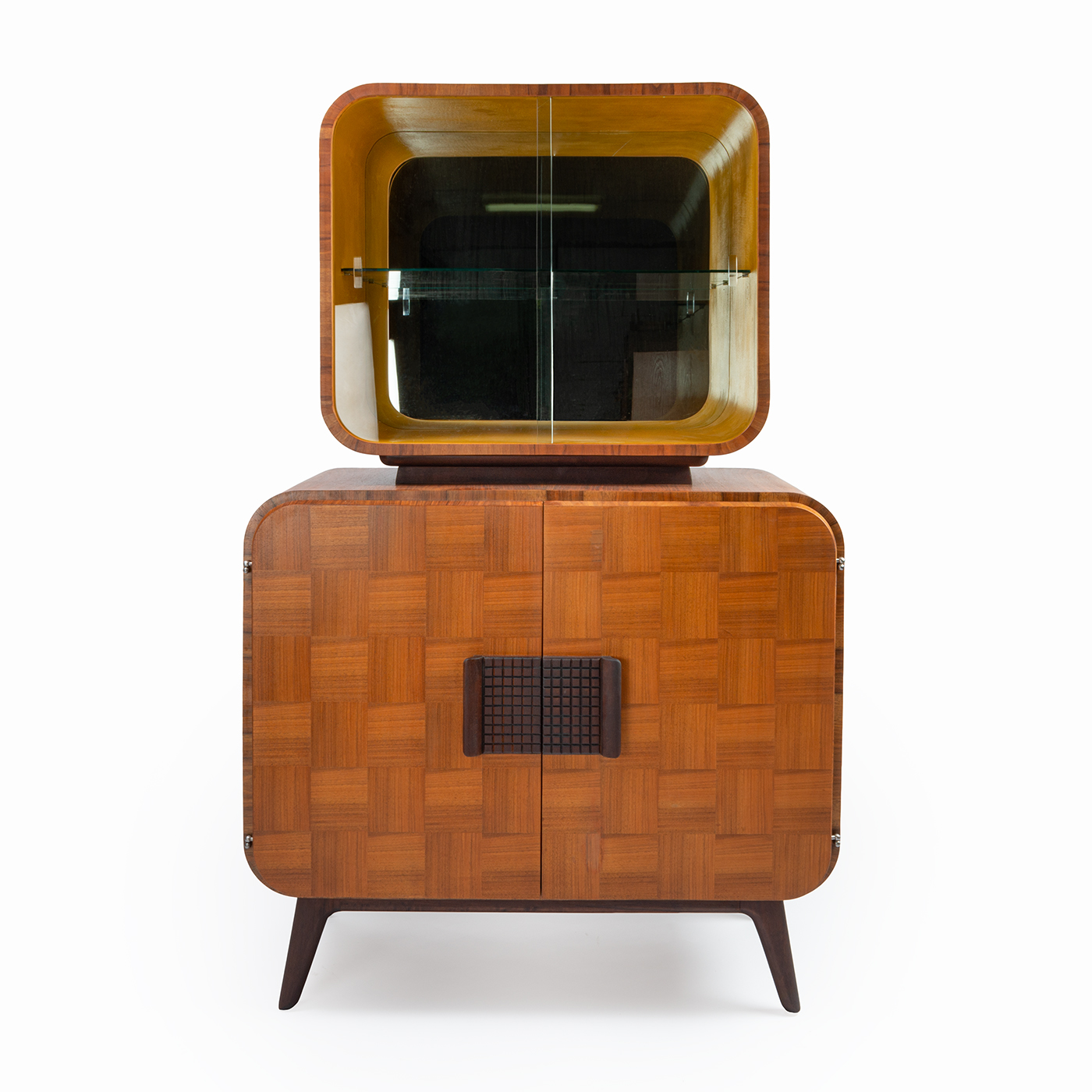
Sideboard with vitrine
Sideboard with vitrine designed by Jindřich Halabala in 1946 for the company Uměleckoprůmyslové Závody. This perfect and complex design was intended for the British market after World War II, when there was a furniture shortage in all the large cities that had been bombed during the war. The sideboard was in production for a mere two years, mostly for export, before its production was discontinued due to the regime change in Czechoslovakia, which resulted in a shift in trade relations with Great Britain.
In this piece, Halabala combined a traditional material with the delicate, rounded lines of a modern aesthetic. The sideboard is made of oak and has a decorative veneer on the front of the doors with a checkerboard pattern created by alternating squares with perpendicular wood grains. Inside the main cabinet there are two drawers and a shelf. The upper vitrine has sliding glass doors, a glass shelf, and a mirror on the back panel. The sideboard underwent a complete restoration in our workshop using only natural oils and waxes.

Jindřich Halabala
(24.5.1903 - 18.11.1978)
Jindřich Halabala was a Czech designer, theorist, publicist, teacher, and one of the most interesting figures involved in furniture production in the inter-war and post-war periods. He was among the first proponents of mass production in Czechoslovakia, and his name will always be associated with the company UP Závody, which, thanks to Halabala’s skill and ingenuity, became one of the finest furniture manufacturers in Europe. Halabala’s sleek, functionalist pieces have been representing Czechoslovak design in auction halls around the world for years, and he is without a doubt the most well-known Czech furniture designer of the twentieth century.
Halabala was born in 1903 into a family of cabinetmakers, and as a teenager he learned the family trade in his father’s joinery workshop. In 1920, he enrolled at the State School for Wood Processing in Valašské Meziříčí, where he completed his studies in two years. When he was not yet 20 years old, he moved to Prague to attend the Academy of Arts, Architecture & Design in the studio of Professor Pavel Janák with a specialization in furniture and interior design. Halabala completed his studies in 1926 and created his first designs for furniture and carpets that same year.

After his studies, Halabala was briefly employed at the studio of Bohumil Hübschmann, but in 1928 he joined UP Závody as the manager of their Prague shop in Palace Lucerna. In 1930, he was transferred to the company’s headquarters in Brno to take over as the manager of their design studio. He worked there in different capacities until 1946, and he was instrumental in planning their entire approach to production, promotion, and sales.
Halabala became a close partner of Managing Director Vladimír Mareček, and in addition to his many responsibilities in the company, he also gained a number of new competencies. He was in charge of the composition of the production range, and he himself created the majority of the designs for their furniture in the H series. He determined the nature of product promotion, in which he personally participated as a photographer. It was this collaboration between Halabala and Mareček that decided the direction of the entire company. Their goal was to be able to offer high-quality products at favourable prices by utilizing the most efficient methods of mass production possible. In doing so, they were able to make their products available to a much wider segment of the population.
Halabala’s furniture became a common sight in Czech households in the inter-war and post-war periods. He was involved in the development of UP Závody’s H and E lines of modular furniture, and he also innovated new seating designs using tubular steel frames. His carpet designs, which were often used in promotional materials and photographs, are comparable in quality to those of Czech designer Antonín Kybal.

In the 1950s, after UP Závody was nationalized, it was one of the largest furniture manufacturers in Europe, yet Halabala’s designs maintained their quality and creativity in spite of political pressures. He also began to take an interest in sharing his knowledge with the next generation of designers, and from 1951 to 1954 he was a guest lecturer at the Faculty of Forestry & Timber Engineering at VŠPD in Košice.
By the time he retired in 1970, Halabala had become a leading inspiration for designers all over Europe.

UP Závody
The company Spojené Uměleckoprůmyslové Závody (Associated Arts & Crafts Enterprises) was a renowned Czechoslovak furniture manufacturer and retailer based in Brno.
UP Závody was founded in 1918 by Jan Vaňek, who then merged his enterprise with the joinery business of Karel Slavíček in 1920. UP Závody manufactured simple, functional, practical furniture, and their sales strategy was based on consistent advertising in the magazine Bytová Kultura (Apartment Culture).
After Jindřich Halabala joined the company in 1928, they began producing their H series line of modular furniture, which was characterized not only by its modern shapes but also by the careful selection of materials used in production. The veneers were made from high-quality Canadian walnut and mahogany, and they often used oak and other species with interesting wood grains in their production as well. Halabala also designed a number of carpets featuring abstract geometric patterns for UP Závody.
The company was nationalized in 1946 but continued to maintain the quality of its products for years. Gradually, however, they came under more and more pressure to make cheap, mass-produced furniture, for example, their U series, which was primarily exported to Russia and Mongolia. Given the large quantities that had to be produced, they had to compromise on quality. In 1991, UP Závody was taken over by Tusculum, and then in 2003, Tusculum was acquired by Jitona, and the companies were later merged.
Photos can only be published with written permission from Nanovo.
Photos by Dita Havránková
Product photos by Damián Skořepa
